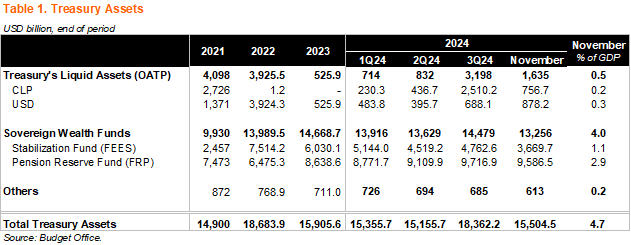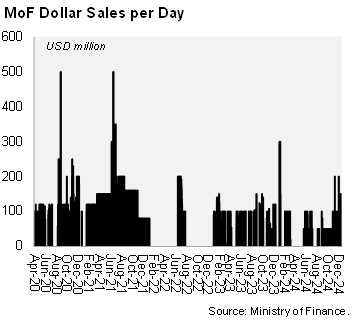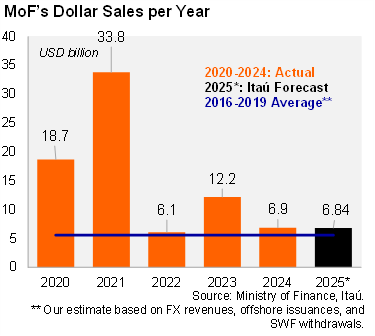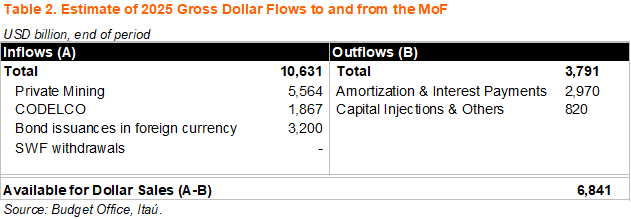Some historical context on the MoF’s dollar sales. As we have mentioned in previous reports, the MoF has been an active participant in the local foreign exchange spot market in recent years. In March of 2020 the MoF announced they would competitively auction dollars from the Treasury to finance the high and rising expenditure needs related to the pandemic, further enhancing fiscal transparency, and providing additional guidance regarding the Government’s participation in the local FX market (press release in Spanish here).
Dollar sales finance the deficit, not with an exchange rate target in mind. Dollar sales through auctions finance the government’s fiscal needs (primarily in pesos), disregarding exchange rate considerations, in line with Chile’s free-floating exchange rate regime.
Stock of dollar holdings. The Central Government’s official dollar holdings are mainly booked in the Treasury and the sovereign wealth funds (Stabilization Fund and the Pension Reserve Fund). Liquid assets in dollars held at the Treasury (Otros Activos del Tesoro Público) by the end of November reached USD878 million. The SWFs are entirely invested abroad, with the Stabilization Fund reaching roughly USD3.7 billion (1.1% of GDP), and the Pension Reserve Fund at USD9.6 billion (2.9% of GDP), both by the end of November. Separately, the Central Bank also manages international reserves, which as of the end of November reached USD44.9 billion (roughly 13.8% of GDP).

Dollar flows to the Treasury. Dollar assets in the Treasury are accumulated primarily from offshore bond sales, loans from multilateral financial institutions, copper-related revenue, periodic withdrawals from the sovereign wealth funds, and (less common) transfers from state-owned companies. The MoF enjoys a dollar surplus on a flow basis, as dollar inflows largely exceed dollar outflows. The latter are mainly in the form of foreign currency denominated debt amortization and interest payments, periodic transfers to the SWFs and other funds.
Sales in 2024 were sizable, yet below 2023. In 2024, the MoF sold a total of USD6.892 billion, on 79 trading days, selling an average of USD87.2 million per day in which sales took place. The minimum sold on a given day was USD20 million, and the maximum USD300 million. Overall, total sales in 2024 were below the USD12.2 billion of 2023, yet above our estimate for dollars sold on average for the 2016-2019 period (USD5.6 billion).

MoF to sell a similar amount in 2025. Importantly, the MoF does not announce an annual dollar sales forecast. Rather it has recently announced a maximum weekly guidance valid for several months. The last guidance was announced on November 13, and they have yet to announce their guidance for dollar sales in January 2025. According to our estimates, the MoF would have gross dollar inflows in 2025 of roughly USD 10.6 billion and gross outflows for USD3.8 billion, which would leave room for dollar sales during the year of up to USD6.8 billion (see details in Table 2). Dollar inflows from copper-related sources consider an average price of USD4,30 during 2025; a lower copper price would lead to fewer dollar inflows to the MoF, and hence less dollars to sell. We see the MoF announcing a total gross 2025 debt issuance plan of USD16 billion, of which we consider 20% would be in foreign currency. Our estimates do not consider significant withdrawals from the SWFs in 2025.


What to look out for. We estimate that the MoF ended 2024 with a very low liquid dollar balance, suggesting that in the near term we should not expect dollar sales to take place on a regular basis. We expect the MoF to announce their 2025 debt program in the coming days, which we envisage to total roughly USD16 billion in gross terms, with focus on the share of foreign currency denominated issuance. A sizable debt issuance in foreign currency is likely to take place this month, in line with recent years. However, we believe the lion’s share of this issuance would cover amortizations of a euro-denominated bond for EUR1.6 billion by the end of the month, and interest payments in foreign currency for ~USD400 million. Still, dollar sales would resume more regularly after this issuance, likely by the end of the month.
